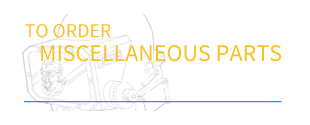Helmet Identification
Types of Diving Helmets
While the Mark V helmet is the best known, other types of helmets preceded it. Most common are the commercial and the sponge or lightweight helmets. Other types include shallow water and low volume helmets. Low volume helmets can be divided into free flow, demand, and mixed gas variants.
Commercial Diving Helmets
The commercial diving helmet traces back to the mid 19th century. The breastplate is a twelve bolt type (meaning 12 studs pass through the collar and brails) which is very wide across the shoulders, falls fairly deep in front, but falls shorter in the back. It is constructed to take rigorous use so the Copper and Brass parts are all made heavy. Three lights (windows) front screw in, and sides were standard. The side windows are generally oval and can be oriented horizontal or vertical. Optionally a top window could be installed. After the Mark V came out exhaust and communications from it became available on commercial helmets. The helmet shell shape is different than a Mark V. The commercial shell is often referred to as a bubble shell.
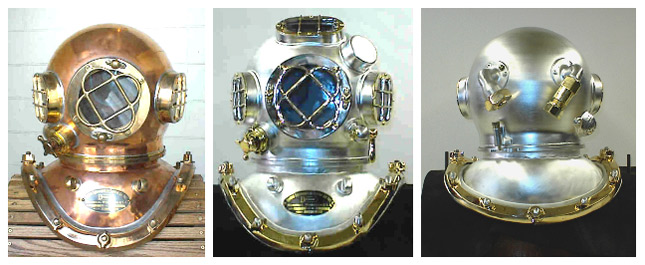
Variants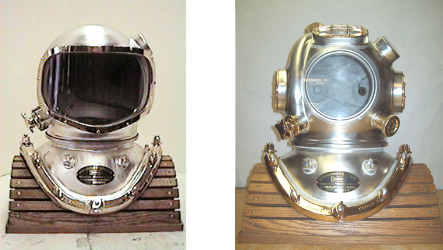
Variants of the commercial helmet include the Fisheries Helmet with a single large window, and the Nuclear with a plastic screw in front window, Helium helmet exhaust valve, and integrated air control valve.
Sponge (Lightweight) Helmets
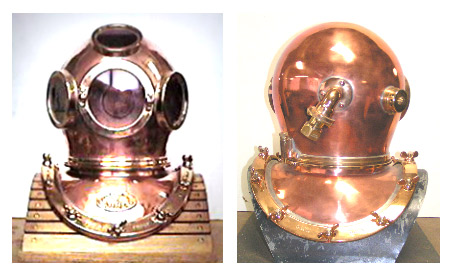 The name Sponge Helmet refers to a particular model of helmet but is also used as a generic term for lightweight helmets which use the same breastplate and top shell. The Sponge helmet was developed for divers harvesting sponges. The helmet is lighter and more compact. Sponge divers would spend most of the day underwater and having the lightest gear possible would reduce fatigue. Sponge helmets are cheaper and easier to maintain which appealed to frugal Greeks and Conchs. This is the helmet of the Mediterranean Sea and the Florida Keys. The helmet came stock minus communications and with a simple head butt exhaust valve.
The name Sponge Helmet refers to a particular model of helmet but is also used as a generic term for lightweight helmets which use the same breastplate and top shell. The Sponge helmet was developed for divers harvesting sponges. The helmet is lighter and more compact. Sponge divers would spend most of the day underwater and having the lightest gear possible would reduce fatigue. Sponge helmets are cheaper and easier to maintain which appealed to frugal Greeks and Conchs. This is the helmet of the Mediterranean Sea and the Florida Keys. The helmet came stock minus communications and with a simple head butt exhaust valve.
Variants
As stated above "Sponge" also referred to a class of helmets. Different fisheries had different requirements so various models of helmets developed. DESCO makes the Abalone, Agar, Fisheries, and Browne Commercial helmets on the Sponge breastplate and shell.

Abalone helmets had guards with bars over the windows and a Mark V exhaust valve. Agar helmets have rings without bars for the windows and a adjustable single spring head butt exhaust. The Lightweight Fisheries has the Mark V exhaust valve. The Browne Commercial helmet has large screw in Acrylic windows, an integrated air control valve, and a low profile air inlet/communications block. It also has a double exhaust valve using a Mark V exhaust primary and a fixed flapper secondary exhaust.
Dress Collars
The helmet needs to mate to a dress for a watertight seal. this is accomplished with a gasket known as a collar. The collar shape conforms to the breastplate, slipping over the brail studs, and is squeezed between the brails and breastplate. There are three standard collar patterns. First i the Mark V collar which obviously is used with a USN Mark V Helmet. The second is the Commercial collar. Lastly is the Sponge collar.
The Mark V and Sponge resemble each other but the Mark V is larger overall. The Commercial collar looks looks a horse collar. The Sponge collar is the most universal of the three. American lightweight helmets, Asian helmets, and some European helmets used this pattern. In second is the Commercial collar. Morse, Schrader, and DESCO all made helmets of this style.
Shallow Water Helmets
These helmets are the simplest and easiest to use of all helmets. No suit is used. the helmet rests on the diver's shoulders and air exhausts from under the breastplate. The top and breastplate are one unit permanently joined. One to four windows of various shapes can be installed.
Low Volume Helmets
Low volume helmets are available in free flow and demand models. DESCO Air Hats share(d) the market with the likes of KM Superlites™, Miller, Savoie, Gorski, CBE, and Aquadyne.
How do I know the helmet I'm about to bid on is the real thing?
The collector market for all types of items has exploded in recent years. At one time it may have taken decades to find a particular item for a collection. With the advent of the internet many things are now just a mouse click away. The availability and ease of online shopping has created a booming market in all types of collectables. Most sellers online are honest which is why the system works. Still a buyer must be wary when bidding or purchasing online. In some cases the seller is not knowledgeable in the item they are trying to sell. This can lead to inadvertently advertising a article as genuine or antique when it is not. Other times unscrupulous sellers will attempt to pass off replicas or reproductions as authentic. In the diving equipment arena this is not just crooked, it could be deadly. Some collectors are also historical diving enthusiasts. They have the proper experience and/or training to determine the suitability of using a particular piece of equipment, or not. Novice collectors might purchase a helmet and unknowingly attempt to dive a replica. These helmets are never to be used underwater. The results can be catastrophic.
This page is dedicated to supplying information to assist in determining a "real" helmet from a replica. It focuses primarily on the U.S. Navy Mark V Helmet as this is the one most people associate with deep sea diving. Some unenlightened sellers will mistakenly label other types of helmets as Mark V helmets. The Mark V is one model of helmet in a broad range of styles and types.
DIVING HELMET SAFETY WARNING
NEVER, EVER DIVE A HELMET UNLESS YOU ARE ABSOLUTELY SURE IT IS GENUINE AND IN PROPER WORKING CONDITION. Replica helmets are not designed or built for actual use. Attempting to dive a replica helmet could result in serious injury or death. Only dive after you have received the proper training.
Replica/Reproduction Diving Helmets
First things first. The term "Replica" is a misnomer. According to Webster replica means: 1. an exact reproduction (as of a painting) executed by the original artist, 2. a copy exact in all details <DNA makes a replica of itself>. "Reproduction" similarly is misleading: something reproduced : copy. Since we are stuck with an imperfect language these names must be applied even though the "replica" helmets are hardly exact copies.
Many replica Mark V helmets are currently on the market. These helmets often have authentic looking tags with the names of legitimate manufacturers on them. The most common replica has a "Morse" Diving nametag, and there is a replica around with a "Diving Equipment & Supply" nametag. This was an attempt to make the helmets more authentic but can lead some buyers astray. The most blatant fake is one bearing a nametag which says "Brooklyn Navy Yard 1911". The Mark V didn't even enter service till 1916. People have purchased replica helmets believing they are genuine. When considering the purchase of any diving helmet do some research before you commit.
Some things to look for are the telephone cup set back on the helmet top. Copper sheet used to make exhaust banana tube instead of the real cast brass tube. The top window set too far up on the top. Window frames held in with screws. No ductwork inside the helmet. The top and breastplate held together by set screws instead of interrupted threads. Two piece air and communication elbows. A front door pin which is not removable. A "stove pipe' appearance to the breastplate instead of the rounded appearance of a genuine Mark V breastplate. The Spitcock stem is held in with a large round nut instead of a washer and hex nut.
On the popular selling websites you will find various fake diving helmets. DESCO used to sell a reproduction helmet for decorating purposes (the one on the left above) as a alternative spending several thousand dollars for a fully functional DESCO Classic helmet. The importer we procured our repro helmets from discontinued them due to spiraling costs for the helmets and shipping from the far East. The one we sold was the best example of a replica we could find. Obvious differences were the brails, telephone cup, and banana exhaust tube and star wheel.
Here are some close up photos of the reproduction Mark V helmet we used to sell.
Above are photos comparing a replica helmet we used to sell to an actual USN Mark V Helmet. The differences are obvious.
Here are some detail photos.
What is a U.S. Navy Mark V Diving Helmet?
Below are some things to look for in a genuine Mark V Helmet.
The real United States Navy Mark V Mod.1 Diving Helmet History
At the turn of the 20th century the U.S. Navy didn't have a standardized system for diving. The inventory of diving equipment in the U.S. Navy was a hodgepodge of various helmets, suits, pumps, and hoses by several manufacturers. Often as not pieces would not work together, making even simple assignments difficult. In 1912 U.S. Navy gunner G. D. Stillson submitted a report criticizing the way the Navy conducted its diving program. The Navy agreed and a group was formed in 1914 to standardize equipment and procedures. The original concept drawing is shown above. The Spitcock and Exhaust Valve are on the same side. The breastplate resembles a Commercial breastplate in the shape of the collar strap. In the 1916 U.S. Navy Diving Manual the Mark V Helmet first appears in its adopted form. The breastplate shape is unique to the Mark V being narrow across the shoulders and with a deep drop front and back. Some features remained from the concept helmet above with the exhaust valve on the right, a hinged front door, and air and communications elbows. The spitcock was moved to the left of the door, and guards specific to the Mark V were added.
All U.S. Navy Mark V helmets generally conform to a standard set of plans issued by the Bureau of Ships. Helmet shell, breastplate, all fittings and attachments are designed so regardless of the manufacturer all equipment would be compatible. Some small variances do occur between manufacturers but do not effect interchangeability. Four manufacturers made US Navy Diving Gear during World War Two, Morse of Boston MA, Schrader of Brooklyn NY, Diving Equipment & Supply Co. of Milwaukee WI, and Miller Dunn of Miami FL. Miller Dunn ceased operation not long after the war. Schrader was sold to Craftsweld and production stopped in the 1990's. Morse and DESCO are the last two manufacturers of the USN Mark V helmet. There is a builder of collector sponge helmets made to order in the Florida Keys. They are high value works of art, not helmets which would be casually used.
Typical features of the Mark V Helmet are as follows:
Click on the picture to enlarge. Use your back button to return.
Click on the picture to enlarge. Use your back button to return.
- The helmet shell tapers to the neck ring. (Note: This rule is not hard and fast as some Mark V helmets were produced with a "bubble shell". Do not discount the authenticity of a helmet on this point alone.)
- The front door is hinged and closure is with a toggle bolt. The hinge has a removable pin to remove the door, or attach a welding shield.
- The Mark V helmet is fitted with round side windows and an oval top window.
- The helmet has a air inlet elbow with a separate non return valve. Both the air and communications elbows are one piece castings, riveted and soldered in place with backing washers inside of the helmet. You normally cannot see the air inlet backing washer due to the ductwork inside the helmet.
- The helmet has a communications elbow fitted to accept a standard U.S. Navy Communications/Lifeline (1.715-11 thread).
- The helmet is fitted with a telephone cup and transceiver. The telephone cup has a shape specific to the Mark V with a bump out pointed towards the top center of the shell. The placement of the telephone cup is symmetrical between the top, left side window, and front door.
- The Mark V helmet has a double spring adjustable exhaust valve with a exhaust tube extending under and behind the right side window. The exhaust body (known as a banana exhaust because of the shape) is a one piece brass casting its entire length. The exhaust can be activated from the inside by the diver with his chin. The bulb on the end of the exhaust is drilled with vent holes. The pattern of these holes varies some by manufacturer.
- The helmet is fitted with a ball lever lock assembly. The ball lever pivots down from the top into a lockstop on the breastplate neck ring. The lock is closed with a latch which is secured with a cotter pin on a chain. Some Schrader helmets were fitted with a latch made from a piece of flat sheet stock. The lockstop was also slightly different from USN specifications.
- The Mark V Breastplate has a unique shape. It is narrow across the shoulders, and deep on the chest and back. The front and back are nearly symmetrical.
- The top and breastplate are joined by interrupted thread neck rings. The shell makes a 1/8 turn clockwise to seal the connection.
- The Mark V Helmet uses its own style wingnuts. The four wingnuts at the brail joints are flanged.
- The Mark V helmet is fitted with 2 loops on the front of the breastplate.
- Most war years Mark V Helmets used a exhaust valve made by the Batteryless Telephone Equipment Company. BTE will be stamped on the flat area of the exhaust handle (star wheel). Later DESCO helmets uses our own 4 point exhaust handle which is rounder than the BTE.
- A Mark V has a standard finish of tin plating (silver color) specified by BuShips . Many Mark V helmets have been polished by the owners or specially ordered as polished from the factory.
Helmet Identification Tags
Often the only way to authenticate an old helmet is by its tag. One should always be wary of taking an ID tag at face value. The most popular replica helmets have believable tags on them. It is not too difficult to forge a tag.
DESCO used three different tags for USN Mark V helmets. All three are etched sheet Brass with a black enamel background. The first two are referred to as football tags due to their shape. We have seen a few early war helmets with the Corp. tag on them. Our best guess is those tags were made incorrectly as the company name was "Diving Equipment & Supply Company Incorporated", not "Diving Equipment & Supply Corporation". The press of war production most likely compelled them to use the incorrect tags to meet delivery deadlines and not waste Brass. We don't have much in the way of documentation from the period so this is speculation on our part. In 2004 we worked on a breastplate that was dated 3-25-43 that had the Corp tag (see photo below). On our office wall is a photo of a Mark V with the Co. Inc. tag dated 11-1-43. The changeover must have occurred between April and November of 1943. Our estimate is we produced between 550 to 575 Mark V helmets in 1943. This estimate is based our our recording of helmets still in existence we know about. Our list has #214 dated 3-25-43 and #773 dated 12-21-43.
The USN specs actually called for oval tags like the third one. When DESCO changed its name from salvage to supply the new tags were designed to conform. The deviation of the earlier tags from the specification may be due to DESCO having tags for other helmets with the football shape. Adjusting the Mark V tag to this shape would allow for using a single blank and would save tooling and material, both necessary during the war.
Early war DESCO (Diving Equipment & Salvage Corp.) Mark V Tag. Note it says "MARK V" in the center and 'CORP" instead of "CO. INC.".
Late war DESCO (Diving Equipment & Salvage Co. Inc.) Mark V Tag. Note it says "MARK V - MOD 1" in the center.
Post war to current DESCO Mark V tag.
Large generic DESCO tag. This tag could be used on any helmet. It is currently used on the three and four light Commercial helmets, the Nuclear helmet, and the Fisheries helmets. This tag is also used on the Abalone, and Agar helmets.
Browne Commercial tag currently used on the Browne Commercial helmet.
DESCO Browne Sponge helmet tag in sheet Brass. Use of this tag ended with the supply of tags about ten years ago.
Cast DESCO Browne Sponge helmet tag made to replace the above tag is currently in use.
Cast DESCO Air Hat Tag is soldered to the left side of the snout. This tag was also used on an Abalone helmet that was stolen while on its way to Houston for a ADC Underwater convention in the mid 90's.
Cast DESCO "Salvage" tag was used on the Commercial helmets and Utility helmets. It is currently used on the Shallow Water helmets.
Small generic DESCO tag used on miscellaneous products like air compressors.
Some other manufacturers tags
John Date
Alfred Hale
C. E. Heinke
Miller Dunn
Morse
Schrader
Siebe Gorman
C. H. Sanborn
Chinese
Japanese
Korean
Sponge (Tarpon FL?)
Forgeries
This is a cast remake of the early DESCO Mark V tag . The real tag is made of sheet Brass.
This is a remake of a Morse Mark V tag with a fairly obvious flaw. (Clue: photo is not out of focus)
This is the tag from the replica Mark V Helmet which is a copy of the tag above. Even though the tag above is distorted it is obvious that the quality of the lettering and the casting is higher than on this one.
This tag is from a really bad Mark V replica. The helmet wouldn't fool anyone so the tag shouldn't either. This one is from the DESCO Mark V replica in the replica helmet section above.
Other Identifiers
Some other things to look for are serial numbers and inspection stamps.
Customizations and modifications
Some times the original configuration isn't acceptable to a particular diver. Back in the day diver's were like farmers, willing and able to take a saw or torch to a piece of equipment and make it work "their way". The big three helmet makers of the time (Morse, Schrader, and DESCO) were willing to mix and match stock parts to a customer's specifications. They would also where possible retrofit old helmets. Customized helmets are not as uncommon as one might expect. A few years ago a retired physician contacted us about a old DESCO Mark V (#3038) he had on display in his office. He was looking for a good home for it so we purchased it for our display room. Somewhere along the line the standard front door was removed and a Morse screw in commercial door installed. Also some work was done to the exhaust valve, and a spring lock replaced the dumbbell lock. The helmet is still fully authentic but not in original condition.
Photos of a DESCO Mark V helmet (#671) sent to us by a collector demonstrates how severe some modifications can be. The Mark V had all the windows enlarged. This helmet had great visibility.
Serial Numbers
Different manufacturers had differing protocols on how their products were numbered. Some products were sold without serial number at all, which can complicate authentication or establishing the age of a authentic piece. On bonnet and breastplate helmets look for serial numbers straddling the center mark on the front of the neck rings. Doing some research into the labeling protocols of the different manufacturers can give you more confidence in the ability to identify a authentic helmet.
This Morse Commercial helmet has the serial number stamped across the center marks on the rings.
There is a generic tag on the breastplate without provision for stamping a number.
The serial number stamped into the ring of this Siebe Gorman helmet has a error in it. The last digit was stamped and then corrected.
It appears it was stamped 19767 by mistake and a 6 was stamped over the 7.
The size and shape of the font is consistent so it is reasonable to believe this was done at the time of manufacture.
What indicates the 6 was stamped over the 7 is that the 6 is deeper and a bit distorted denoting it was stamped much harder.
We have learned through our own experience that we tend to over stamp in part to obscure the incorrect digit, and through frustration at making such a simple error.
Don't necessarily dismiss a helmet as not genuine due solely on a detail like this.
Location of the serial numbers alone also cannot be used solely to determine authenticity. Currently DESCO stamps serial numbers between the interrupted threads, towards the back on the top ring. The serial number on the bottom ring is stamped inside the ring, center back. During WWII the serial numbers were in the forward part of the rings.
In the late 1950's the serial numbers on the DESCO Mark V helmets had reached into the 6000's. A decision was made to start over. An example is a DESCO Mark V #397 was dated 6/6/43 and a second DESCO Mark V #397 is dated 01/01/08. The first went to the US Navy and the second was a HDS raffle helmet. Both are genuine DESCO Mark V Diving helmets.
U.S. Government Inspection Mark
Certain products sold to the government required a inspector to look at the product then approve it. The product would be stamped with a special mark. On diving helmets this mark is an anchor with US on straddling the anchor's stock. If you see this mark it indicates that the helmet was sold to the government for naval service. After WWII large amounts of surplus diving equipment flooded the commercial market. Helmets from the period are not rare and most will have been in government service. The inspectors mark has appeared in different places on helmets we have seen. Sometimes they are on the tag, the neck ring, or the telephone cup. There appears to be at least two styles of anchor used in the inspectors mark.
Finally, although the U.S. Navy issued the drawings and specifications for the Mark V Helmet, with the intent that regardless of who made it all would be interchangeable, there is some variance between helmets made by the four companies. Miller Dunn breastplates were tapered more than the others. Minor details were left off some parts like the relief cut on the front door. DESCO being the late comer to Mark V production was the most faithful to the Navy drawings. Morse and Schrader had been making Mark Vs from 1916 on. War production demands had some parts needing to be outsourced. War year helmets usually have exhaust valves made by BT&E. Swapping of parts while in service results in one manufacturers parts being on another's helmet. The best method to decide if a helmet is the real McCoy is first take in the big picture. Does it generally look right? Then move on to examining each major component. Don't worry about a Morse non-return valve on a Schrader helmet. More important is if it a genuine Morse valve.
Mark V Tech
US Navy Double Spring Exhaust Valve
During WWII exhaust assemblies were produced by BTE.
DESCO started making their own after the war ended.
Recreating a historical record
DESCO often receives requests for information on our helmets in order to authenticate them. Our company ownership and location have changed several times in our seventy four year history and virtually all of the old production and sales records were discarded as being unnecessary. This information would be priceless now but alas is long gone.
Please help us assemble a reference record of DESCO and other manufacturer's classic style helmets. This is an effort to recreate some of our production records and fill holes in the information we currently possess. We are seeking information on Mark V & Helium, Commercial, and lightweight helmets which were serial numbered (and dated if so) by their makers. As helmets have passed through our shop we have recorded the information from their tags. This information will help us authenticate helmets as it relates to their serial numbers and dates of mfg.
The data we need is the manufacturer, helmet type, serial number, and date of manufacture. If a helmet is mismatched we would appreciate both serial numbers and where they were located on the helmet. Additional info like current owner and location is desirable but not necessary. The info can be e-mailed to us at diveq@execpc.com or descocorp@sbcglobal.net. It can be faxed to 414-272-2373 or mailed to 240 N Milwaukee Street Milwaukee, WI 53202
Below is a page from the record we are making. It is at the point where DESCO restarted the serial numbers on the US Navy Diving Helmets. Several Helium helmets were purchased by the US Navy at this time for salvage ships and submarine rescue ships then being built. We currently have no information on helmets 104, 105, or 106. The * on helmet 99 under owner/location denote we have information on this helmet's current owner but it has been removed from display on this website. We will not divulge that type of information online or in print media without good cause and with the permission of the party involved.
Serial number sequence restarted.
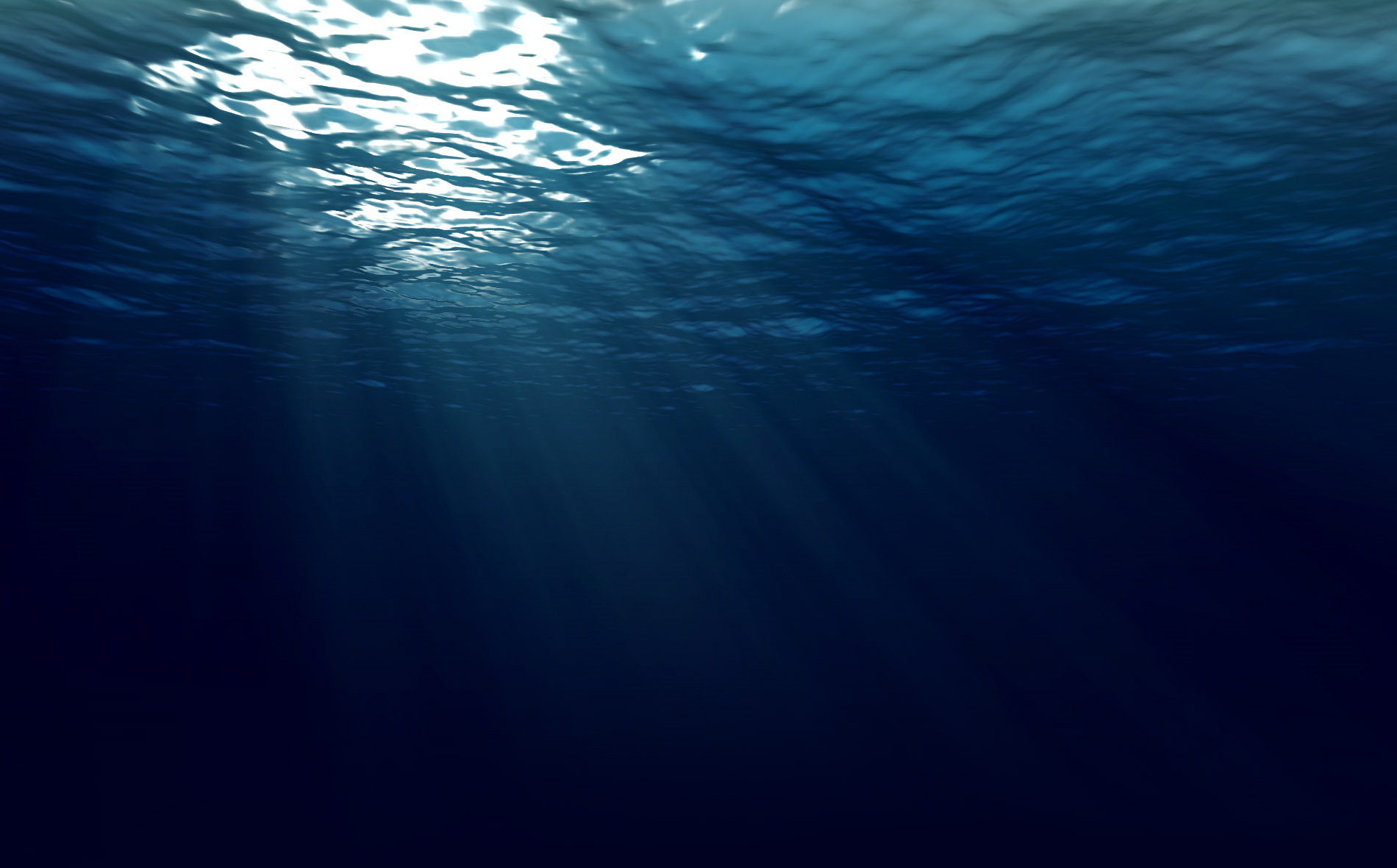

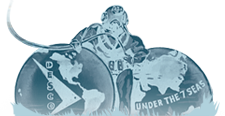

 0 Item(s)
0 Item(s)

